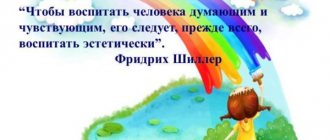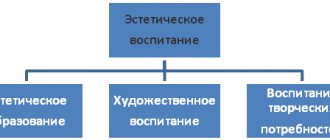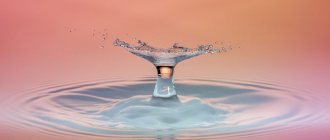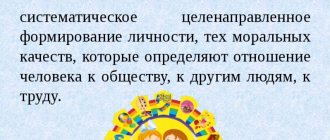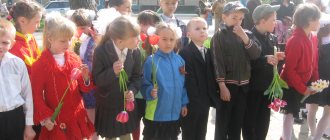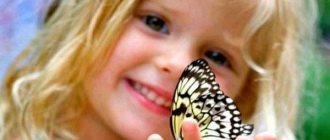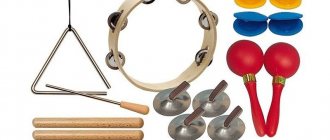The concept and essence of aesthetic education of preschool children
Definition 1
Aesthetic education is a purposeful process of influencing the personality of a preschool child, with the goal of developing his ability to see beauty in the world around him, works of art, as well as the ability to create beauty on his own.
Note 1
Aesthetic education of children must begin from the very first days of life.
Aesthetic education is a purposeful process of developing creative activity in preschool children, the ability to perceive and appreciate beauty in nature, life and art. Aesthetic education of preschool children includes instilling in children an aesthetic attitude towards social life, work, nature, art and everyday life. However, knowledge of works of art is very multifaceted, so it stands out as a separate part of the aesthetic education of children.
Are you an expert in this subject area? We invite you to become the author of the Directory Working Conditions
In the process of aesthetic education, preschool children become acquainted with the beauty in the surrounding life, nature and art, they learn to perceive and feel this beauty. This process contributes to the development of their imagination and imagination.
The system of aesthetic education for preschool children includes:
- education through artistic means;
- education through art;
- education through extra-artistic means (nature, work, environment, educational activities, etc.).
Note 2
Thus, the process of aesthetic education includes general cultural, philosophical and psychological-pedagogical education.
The purpose and objectives of aesthetic education of preschool children
The main goal of aesthetic education of preschool children is to give children the necessary knowledge, skills and abilities from various fields of art, as well as to develop their interest and desire to engage in independent creative activities.
Finished works on a similar topic
Course work Aesthetic education of preschool children 420 ₽ Abstract Aesthetic education of preschool children 230 ₽ Test work Aesthetic education of preschool children 230 ₽
Receive completed work or specialist advice on your educational project Find out the cost
Achieving the main goal of aesthetic education of preschool children is achieved through the consistent solution of a number of the following groups of tasks:
- The first group of tasks of aesthetic education are tasks aimed at developing in children an aesthetic attitude towards the world around them and their acquisition of theoretical knowledge. Includes a number of the following tasks:
- education of aesthetic culture in children;
the formation and development of aesthetic perceptions, feelings and experiences, as well as an aesthetic attitude towards the activities surrounding the child;
- developing in children the ability to see and feel beauty in actions, nature, art, and the world around them;
- cultivate the need for knowledge of beauty;
- nurturing the desire to surround yourself with beauty, to create it with your own hands.
- The second group of tasks of aesthetic education of preschool children is the formation in children of practical skills in the field of various types of arts. Includes:
- teaching children to sculpt, draw, design, sing, and move to music;
formation and development of oral creativity.
Aesthetic education of preschool children within the preschool educational institution involves solving the following problems:
- Carrying out the systematic development of the perception of beauty and aesthetic feelings of children, through various types of arts, activities, emotional involvement, etc.
- Introducing children to art, teaching them practical skills, educating them to bring elements of beauty into the environment as much as possible.
- Formation in children of aesthetic taste and the ability to independently evaluate works of art and life phenomena.
- Development of children's creative and artistic abilities through the organization of activities related to art.
Basic means of aesthetic education in kindergarten
Aesthetic education of children is carried out by familiarizing children with the aesthetics of everyday life, with the beauty in work, in nature, social phenomena, and the means of art.
Teaching a child to feel and understand the beauty of life is a big and difficult task that requires long-term work by adults. The walls of the home, the things that surround a child from the first years of life, have great impact. Comfortable furniture, a harmonious combination of color spots, objects of art, the general style of decorating the room - all this, perceived by sight and touch, is reflected in the memory and consciousness of the baby. The aesthetics of everyday life in a kindergarten is manifested in artistic simplicity, in a thoughtful selection of household items, where each thing has its own place, where there is nothing superfluous. The painting of the walls should be calm, light colors. The requirements for the design of a kindergarten are determined by the tasks of protecting the life and health of children and the content of educational work with them. The main ones are: 1. Expediency, practical justification of the situation. 2. Purity, simplicity, beauty. 3. The right combination of color and light, creating visual contrast that ensures the visibility of each object. For example, pale yellow daffodils next to the blue water of an aquarium enhance the colorfulness of the surroundings. 4. All design components must form a single ensemble. A special place in the design of the group should belong to the visual arts: paintings, prints, objects of applied art. This expands children’s aesthetic ideas, creates a basis for understanding works of art, provides artistic pleasure, and makes them want to draw a pattern, a flower, or make a beautiful toy. The subjects depicted in the paintings should be understandable to children. This is the work of people, the life of a kindergarten, landscapes, still lifes, the life of birds and animals, a fairy-tale world. In all groups, still lifes, prints depicting animals, and paintings with fairy-tale themes can be used. Landscapes are recommended for use in middle, high school and preparatory school groups. Older preschoolers show great interest in reproductions of paintings by famous artists: “The Rooks Have Arrived” by Savrasov, “Golden Autumn”, “March” by Levitan, landscapes by Shishkin, “Alyonushka”, “The Princess and the Gray Wolf” by Vasnetsov, “Girl with Peaches” by Serov, “ Lilac" by Konchalovsky and others. There should be no more than 2-3 paintings in the room. An important place in the design of a kindergarten should belong to works of folk applied art. All groups should have Khokhloma (furniture in the book corner and one or two items that change). It’s good to have a funny Dymkovo toy, gesture trays, and ceramic works. Of course, it is not enough to surround children with beautiful things; we must teach them to see beauty, take care of it, and appreciate it. Therefore, the teacher should draw their attention to the cleanliness of the room, to the beauty that flowers and paintings bring, and encourage the children themselves to try to decorate the room. All this must be learned gradually. For example, observing with the children the work of a junior teacher, the teacher leads them to the conclusion that she not only monitors cleanliness, but also creates comfort in the room. A well-cleaned, sparkling clean room becomes beautiful. And the children themselves gradually get used to maintaining cleanliness and order, first with the help of adults, then at their reminder, and by the older group on their own. From the first years of life, children must be taught the aesthetics of appearance combined with a culture of behavior. In this regard, one of the strongest means of influence is the example of the educator himself, the unity of his internal and external culture. Native nature serves as a powerful means of aesthetic education. Her beauty is especially vividly and deeply perceived in childhood and, imprinted in feelings and thoughts, sweeps through a person’s entire life. The teacher reveals to children the world of nature, helps them see its beauty in a drop of dew on a bud, and in the interweaving of grasses, and in the colors of the sunset... You just need to see this beauty for yourself and find words that are accessible to the child’s heart. Works of art about nature will provide him with invaluable help in this, which he must know well and skillfully use. Streets, buildings, monuments also contribute to the aesthetic and moral education of children. Getting to know their beauty and originality begins with the simplest and closest things: from the kindergarten building, from your street. With age and accumulation of knowledge, the topic of introducing children to the sights of the city and village expands. And no matter where the children live, in the older groups they are sure to be introduced to the capital of our Motherland, Moscow, its Red Square. In the process of this work, educators give children ideas about some of the architectural features of buildings and ensembles, pay attention to the originality of individual forms and lines, to the expediency of architecture, to how it fits into the natural landscape. Children reflect these impressions in construction games. Their buildings are becoming more complex and beautiful. In children's creativity, individual buildings, bridges, and train stations begin to unite into street ensembles. Art is a multifaceted and inexhaustible means of aesthetic education. Works of art are a rich source of joy, aesthetic pleasure, and spiritual enrichment. Many types of it are available to children: literature, music, painting, sculpture, theater, cinema. Each type of art reflects life in its own way and has its own special impact on the child’s mind and feelings. From the first years of life, children are accompanied by oral folk art and children's literature. Fairy tales occupy a special place in their lives. Gave them high marks
: “What a delight these fairy tales are... each of them is a poem.” Not everything can be expressed in words. There are shades of feelings that can be expressed more deeply and fully in music. wrote: “Where words are powerless, a more eloquent language—music—is fully armed.” Music sharpens emotional responsiveness. The child needs it. “Childhood is just as impossible without music as it is impossible without games, without fairy tales,” he was convinced of this. Fine arts are also necessary for a child. It gives him rich visual images. At holidays in kindergarten, different types of art influence children in their originality and unity. Holidays make a strong impression on preschoolers, remain in their memory for a long time and serve as an important means of aesthetic education.
The demands placed on art for children are high. The works selected for preschoolers must be highly artistic, understandable, and meet the objectives of communist education. The artistic material for each subsequent age group gradually becomes more complex due to the deepening of the tasks of aesthetic education. This is taken into account in the “Kindergarten Education Program,” which defines works of art for each age group. Finally, the quality of execution of artistic works for children is very important, on which the aesthetic education of the child largely depends. The leading place in the implementation of aesthetic education belongs to kindergarten. But the role of the family is also great. Only with the unity of the influences of the kindergarten and the family is it possible to fully implement the tasks of aesthetic education. Not every child will become a musician or artist, but every child can and should develop a love and interest in art, develop aesthetic taste, an ear for music, and basic drawing skills. The teacher helps the family create the necessary conditions for the proper aesthetic education of children. He talks about the importance of everyday aesthetics, advises what to read to children, what records to buy for listening to music, and ensures that the child in the family has everything necessary for the manifestation of children's creativity: an album, pencils, paints, toys, books.
Get text
